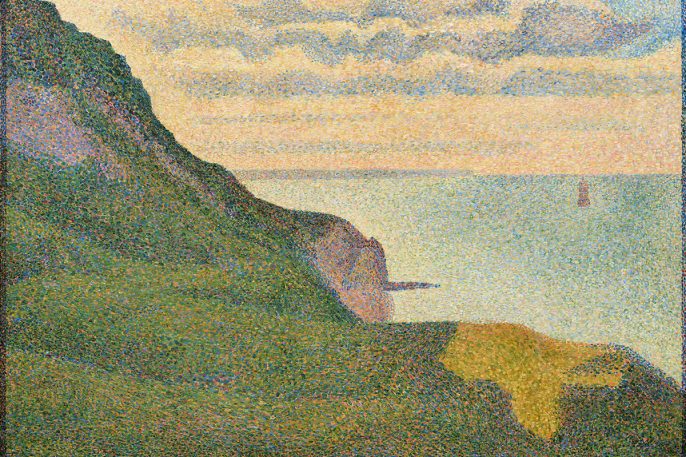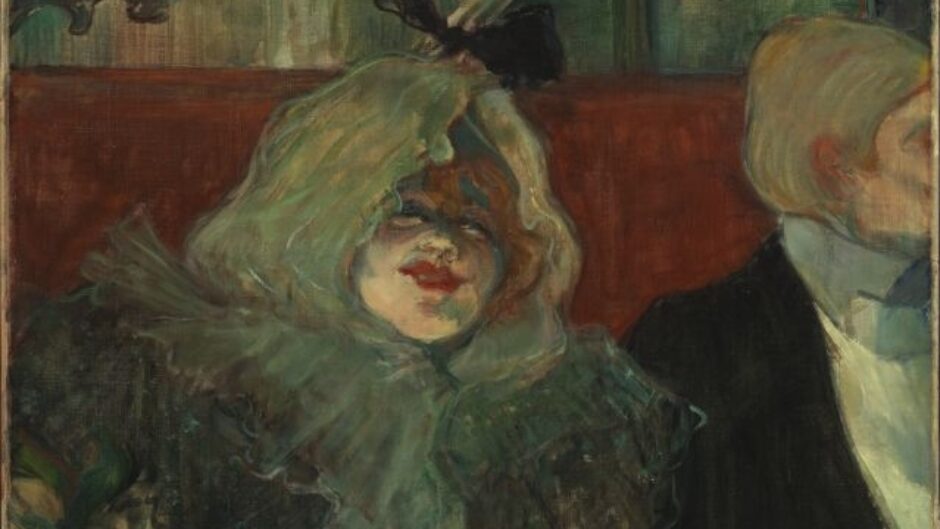Listen to audio descriptions for artworks featured in Good Morning, Midnight, an exhibition curated by the Courtauld MA Curating the Art Museum students.
Henri de Toulouse-Lautrec (1864 - 1901)
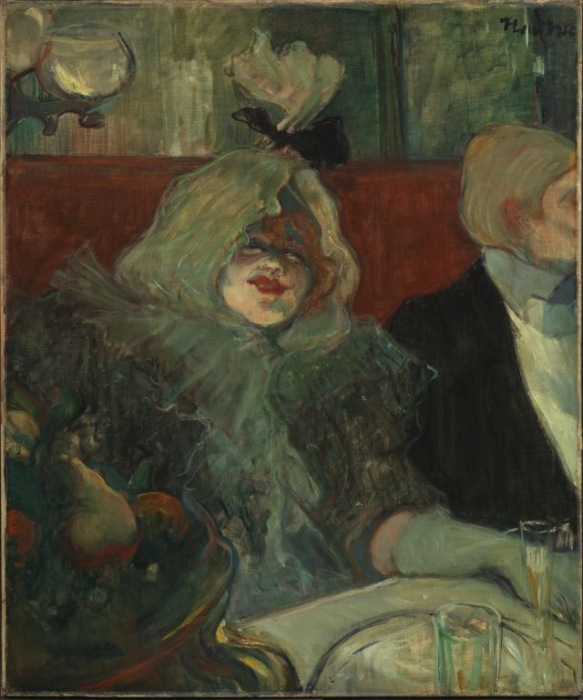
Transcript
This portrait is just over 55 centimetres tall, 46 centimetres wide or close to 2 feet by 1 and a half feet, and set in an ornate wooden frame. Its focal point is a white woman, sitting across a table from the viewer. A white man sits beside her on the right of the image but only the side of his face is visible, his features cropped out of frame. The title of the painting tells us its setting: ‘Le Rat Mort’, one of the emblematic venues of Parisian nightlife near the turn of the twentieth century. The scene is flooded by the eerie green glow of the newly-electrified space. The painting’s artist, Henri de Toulouse-Lautrec, was famed for his closely-observed portrayals of Parisian nighttime entertainment.
Starting from the bottom of the painting, the foreground consists of various items on a table covered with a white tablecloth. On the left is an ornate fruit bowl laden with pears and oranges, and on the right two champagne flutes, evoking luxury, decadence and consumption. These are captured in broad, loose brushstrokes, typical of the post-impressionist style. Moving upward in the picture, a woman takes up most of the pictorial space. Her pose is relaxed, her gloved left arm resting on the table in front of her while she leans back slightly in her seat. She is elaborately dressed, the frills and ruffles of her costume depicted in hazy, translucent brushstrokes. She is thought to be the cocotte Lucy Jourdain, a sex worker and socialite. Her face, tilted back slightly, is lit by a strange light that obscures her features. Her eyes are cast in shadow while the bottom of her face is illuminated, making it the brightest area of the image and the painting’s focal point. Her gaze is uncertain; it is not entirely clear whether her eyes are open or closed. Her lips are painted bright red and drawn into what might be a smile, or perhaps a sneer. To the right of the image, a man is sitting in close proximity to her, dressed in a white shirt and black jacket. Both figures are before a deep red background. The man is turning away from the viewer, his face cropped beyond the canvas’ edge. Through this use of cropping, the viewer is drawn into the gaze and positioning of the artist-spectator. The two champagne flutes on the table implies that the artist is part of the scene, suggesting that he is not a disconnected outsider but a participant in the world he is depicting.
Moving to the top of the painting, Lautrec paints the wall above the seating in loose green washes of colour. In the top left corner of the image is an electric lamp, the light source of the painting and the source of its eerie green glow.
This work is on loan from The Courtauld, London (Samuel Courtauld Trust).
Georges Seurat (1859 - 1891)
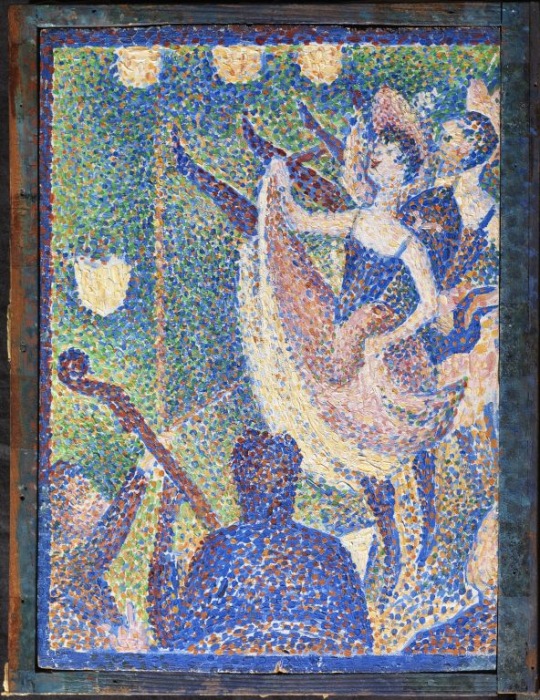
Transcript
Seurat captures the vibrant energy of a performance of the ‘Chahut-cancan’, a dance which became a very popular part of late 19th-century Parisian cafe-concerts. The artist has worked in pointillist style, creating the painting entirely with small daubs of single-coloured paint, mainly blue and green. The painting is very small, around 22 centimetres in height and 16 centimetres across or around 9 by 6 inches. In the top right section is the main subject of the painting, a white woman dancer. She wears a long dress which she lifts to her thigh as she kicks her right leg high in the air. The right legs of the performers in line behind her are also lifted in unison. The atmosphere is feverish and one can almost hear the raucous music which would accompany such erotically-charged performances. The foremost dancer’s expression, her smile and bright-red lipstick, lends her an almost cartoonish quality. In the foreground, the conductor on the left leads the orchestra, accompanied by a cellist at the centre, both with their backs to the viewers, facing the dancers, and depicted in shadowy blues. A mysterious male figure in the bottom right corner hints at the presence of the audience, particularly the gaze of a men-only audience watching the women performers. The scene is illuminated by artificial lights dotted across the top of the painting, which cast a bright glow and create a dreamlike ambience.
This work is on loan from The Courtauld, London (Samuel Courtauld Trust)
Jean-Louis Forain (1852 - 1931)


Transcription
En scène and Danseuse dans les Coulisses are two works by French artist Jean-Louis Forain, both signed in the lower left corner.
En scène is a roughly finished drawing on woven paper in black and brown chalks, pen, and grey ink. It is painted with grey wash, watercolour and bodycolour paints. The work measures 53 by 37 centimetres or roughly 20 by 14 inches and was painted in 1910-1911. The picture shows a stage setting with monumental surroundings. Three ballerinas sit on the stage floor in conversation with two middle-aged men in black suits, who are seen from behind. The figures are rapidly executed and depicted in varying degrees of definition.
The second drawing, Danseuse dans les coulisses, was made in pen and brown ink, watercolour and bodycolour on laid paper prepared with a grey wash. It measures 46 by 29 centimetres or 18 by 11 inches and is dated 1920-1923. In the picture, Forain captures a view from the backstage area of the ballet. A white woman dancer in a white costume is shown in the spotlight, ready to appear on stage. In the background, two spectral figures of middle-aged men in black suits are staring at her. Forain’s rapid execution and loose brushstrokes distort the facial features of his subjects, imbuing them with a profound sense of ambiguity that invites the viewers to interpret the expressions and intentions of each figure, adding complexity and unease to the scenes.
Forain frequently depicted scenes of ballerinas at the Opera: he was given special backstage access to observe the dancers rehearsing and performing. Both works show the behind-the-scenes of the fashionable facade of ballet, exposing its sinister aspects; the dancers are exposed to the leering gaze of middle-aged suitors rather than the cheering audience.
These works are on loan from The Courtauld, London (Samuel Courtauld Trust)
Henri de Toulouse-Lautrec
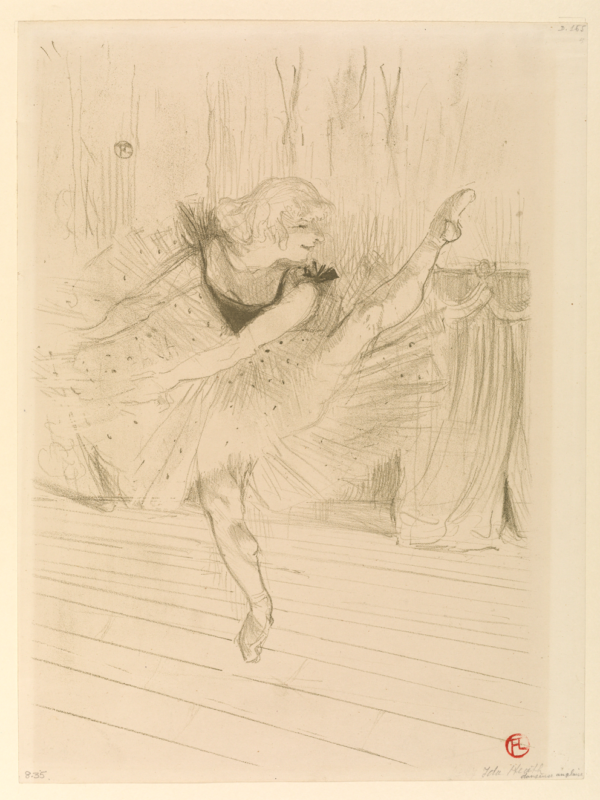
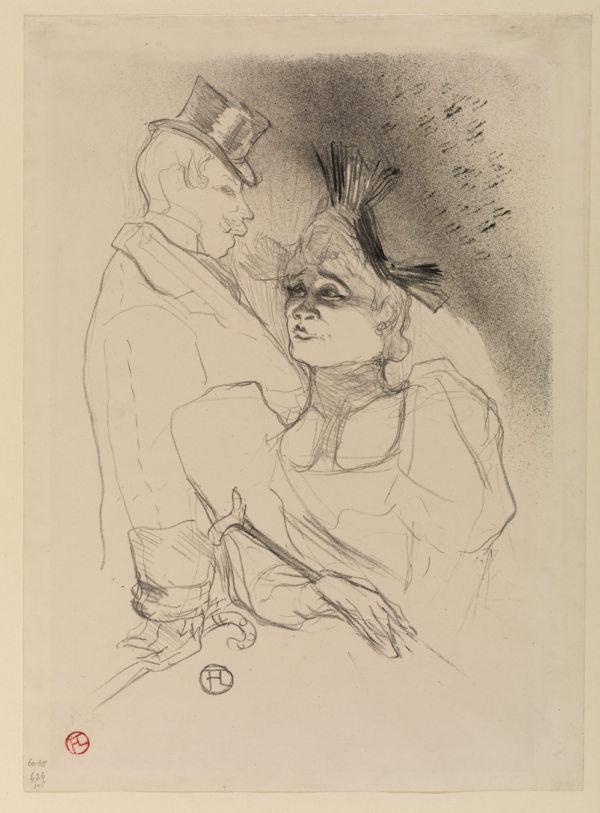
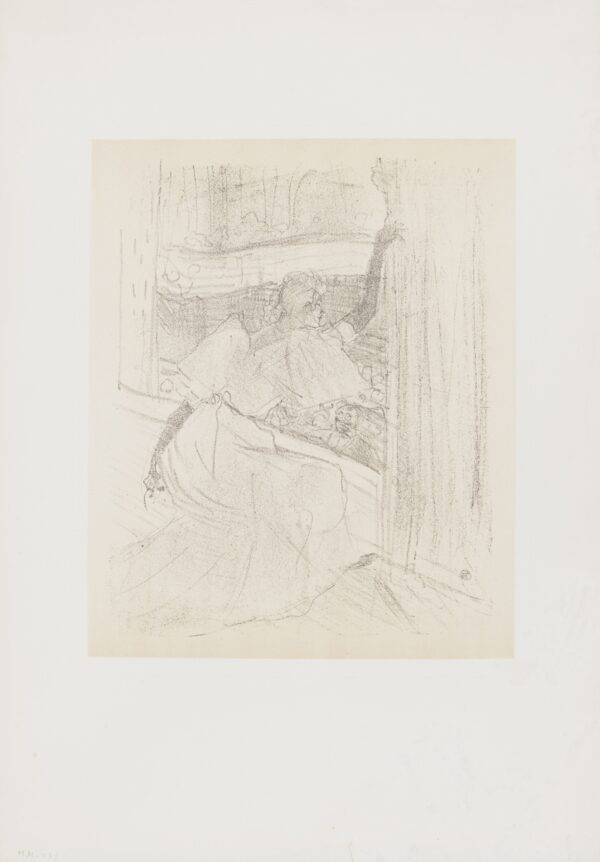
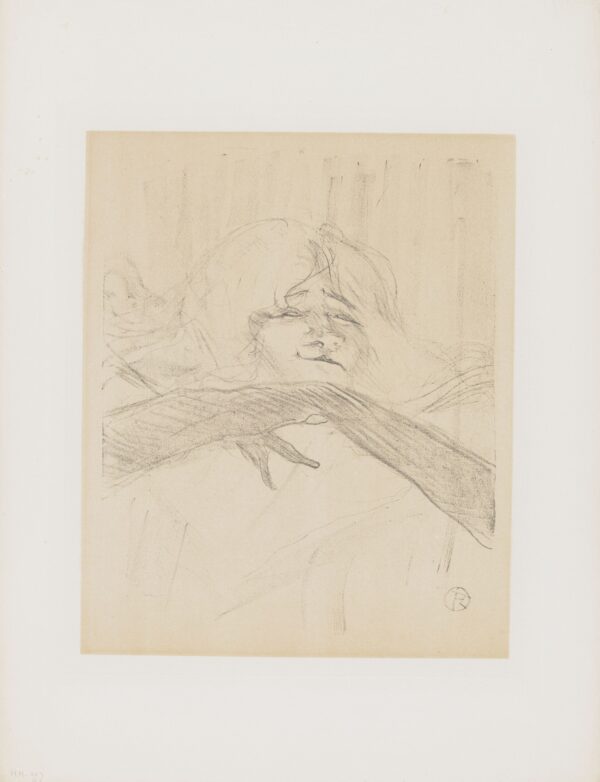

Transcript
These five lithographs by French artist Henri de Toulouse-Lautrec capture the excitement of performance and the vibrant personalities of renowned actresses of his era, including Marcelle Lender, Yvette Gilbert, and dancer Ida Heath. Each lithograph bears the signature of the artist as a monogram of his encircled initials HTL.
Miss Ida Heath, an English dancer, is a lithograph in green ink dating 1896. It measures 36 by 26 centimetres or 14 by 10 inches. In the scene, Heath is shown on a stage while standing ‘on pointe.’ The image captures the dynamic nature of dance performance; dressed in a tutu, Heath kicks her left leg high into the air. Her face, shown in side-profile, is turned down to the left while she swings both her arms to the right.
Marcelle Lender et Baron measures 38 by 27 centimetres or roughly 15 by 11 inches, and was printed in 1893. In the foreground, it shows the flamboyantly dressed Marcelle Lender, with a walking stick resting on her lap. Behind her, a man, shown in side-profile, and dressed in an elegant suit and top hat peers at her in a voyeuristic pose.
Saluant le Public measures 28 by 24 centimetres or roughly 11 by 9 inches, and was printed in 1898. The picture shows a theatre performer on stage. She is captured crouching down from behind-the-curtains, as she peers towards the audience sitting in the theatre. Lautrec represents her as seen from behind and wearing long black gloves and a richly ornate stage dress. The composition blurs the line between spectator and performer, presenting the woman as observer and observed.
Linger, Longer, Loo measures 28 by 24 centimetres or 11 by 9 inches, and was printed in 1898. It is a close-up portrait of a woman performer depicting only her face and hands. She confronts the viewer with a charismatic grin, while resting her head with her gloved hands.
Sur la Scène measures 28 by 24 centimetres or 11 by 9 inches and was printed in 1898. In the middle of the scene, a woman performer, depicted in side-profile, is captured on a stage. The viewpoint of the artist is from an advantaged position from behind the curtains. In the background, some men from the audience are depicted sitting in the theatre, while at the opposite end of the stage a mysterious man in shadow observes the performance. The woman in her stage dress and long black gloves has a euphoric facial expression.
These works are on loan from The Courtauld, London (Samuel Courtauld Trust)
Marlo Pascual (1972 - 2020)
Untitled
2010
Digital c-print on watercolour paper
101.6 x 101.6 cm
On loan from the David and Indrė Roberts Collection
Transcript
A square black and white photograph depicts a dancer holding a pose. This untitled work by Marlo Pascual made in 2010 measures just over 3 feet or 100 centimetres . The photograph is folded vertically so only the dancer’s head is visible on the left half of the fold and their extended leg on the right. The dancer’s head is swung backwards. Expressionless, the dancer looks toward the left corner of the artwork as their black hair descends towards the floor. The image is folded so as to cut the dancer’s head off at the base of the neck; the decapitated head floats in the middle of the composition. Their clothing, if they are wearing any, is not present in this newly constructed image. Beyond their head, only their bare leg is visible, adorned with a dancer’s high-heeled shoe. They put their weight on the ball of their foot, with their heel raised upwards.
The dramatic lighting of the original photograph is retained in Pascual’s work; a dark shadow beneath the dancer and on the wall behind is the only sign of their unseen body. In the background, the floor and wall meet in a dark line, providing a horizontal counterpart to the harsh vertical fold.
Pascual used source imagery that she found to be overly constructed or artificial. She alters the image’s original theatricality by engaging with this medium’s physicality. The artist explained: “as social interactions take place more and more with the screen and the virtual, I find that there is a desire for physical interactions and I play with the possibilities and limitations of those interactions.”
This work is on loan from the David and Indrė Roberts Collection
Susan Meiselas (b. 1948)
From the series Carnival Strippers
The Tease, Essex Junction, Vermont, 1973
Tentful of Marks, Tunbridge, Vermont, 1974
Rained Out, Tunbridge, Vermont, 1974
The Dressing Room, Fryeburg, Maine, 1975
53.5 x 65 cm
Gelatin silver print
On loan from the David and Indrė Roberts Collection
Transcription
This is a selection of four black and white photographs from a much larger series titled Carnival Strippers taken by Susan Meiselas. For this project, Meiselas, a renowned American documentary photographer, spent her summers from 1972 to 1975 capturing and documenting the experiences of women who performed striptease for small town carnivals in New England, Pennsylvania, and South Carolina. Each of the four photographs measures 53 by 65 centimetres or roughly 20 by 24 inches.
In the first photograph, The Tease, bright lights illuminate a scene in a carnival tent. Two performers of colour stand on an elevated stage and engage with two men, seen from behind. A third male spectator peers at the performers in the distance. The performers wear fringed bras that expose their cleavage; the performer on the left wraps a feather boa around her body, while the performer on the right clasps a coat across her stomach. Their legs and feet are out of shot. The men stand in front of the camera lens, taking up over half of the pictorial space. The man closer to the performers leans towards them with his lower arm pointing upwards, holding a cigarette in his hand. The man behind him is identifiable only by his head and the nape of his neck. Although it is unclear what the men are communicating, the performers return their gaze with animated expressions; the performer to the left sticks out her tongue.
Tentful of Marks, captures an erotic performance taking place on a stage in a tent. The photographer’s viewpoint is at the audience’s eye level. At the centre of the photograph, only the legs of the performer are seen from behind, from her bare thighs to her foot, which are clad in high heeled shoes. In front of her, a male-only audience crowds the space. The men’s facial expressions and body language, as they look up to the performer and gesture to her with their hands, express their excitement for the show.
Meiselas’ photographs also capture the performers when they are off stage. The third photograph, Rained Out, is taken outside the performance tent. At the centre of the image is a man with his torso exposed, wearing a wide-open chequered shirt, black trousers with the fly unzipped, and partially exposed boxer shorts. On his left, two women, presumably performers, stand wearing t-shirts and embracing each other in laughter. In the background, to the left side of the photograph, a brightly illuminated ferris wheel can be seen against the dark night sky.
The Dressing Room, Fryeburg, Maine captures a moment of intimacy shared between naked performers relaxing in a private indoor space. One of them is standing at the centre of the image, her head cropped beyond the frame. There are bruises on her arm and leg. She holds a fan of playing cards. Two white women performers are seated behind her; the performer seated to the left clasps her hands in front of her stomach while the performer on the right leans forward attentively, facing the camera, while supporting her head with her left arm. A fourth performer, in the bottom left corner, is identifiable only by her hand, which holds a set of cards.
These works are on loan from the David and Indrė Roberts Collection.
Rose Wylie (b. 1934)
Natural Born Killers, Long-shot (Film Notes)
2018
Oil on canvas
183 x 165 cm
On loan from the David and Indrė Roberts Collection
Transcript
This large oil painting measures 183 by 165 centimetres , which is roughly 6 feet high by 5 feet wide. It is made by the artist Rose Wylie, as part of the ongoing series Film Notes.
A Cadillac car, rendered in pastel pink oil paint, occupies the lower half of the painting. Wylie has painted the outline of the car in a darker shade of pink, and shows little sense of depth. The lighter pink paint extends beyond the outline of the car.Two figures are visible inside the car. The artist has only given a subtle suggestion of the outline of the figures: it is possible to make out the side profile of a man driving the car. A woman appears to lie across the seat, her legs wrapped around the man’s head. She wears a white dress and her head hangs over the edge of the car’s door. This style of quick painting with visible brushstrokes is common across Wylie’s paintings. Around the car, the artist has painted a dark night sky using black paint. Parts of the canvas are left bare. There are streaks of yellow paint around the edges which may suggest light sources against a dark night sky.
Below the car, across the bottom of the canvas, the artist has scrawled two words: ‘Mickey’ and ‘Mallory’ in bold strokes of light yellow paint indicating the subject matter of the painting. Mickey and Mallory are the two protagonists from the 1994 film Natural Born Killers. It is difficult to make out what is happening in the scene.This is deliberate. Wylie painted the scene from memory, and it displays the haziness of recollected detail. Wylie chooses scenes from films in which the visual image particularly strikes her and lodges itself in her memory.
The title of the painting reflects her interest in techniques used by filmmakers, in this case the ‘long shot’. There is a sense of looking at the two figures from afar, evoking a voyeuristic perspective.
This work is on loan from the David and Indrė Roberts Collection
Pádraig Timoney (b. 1968)
Untitled (Still Air in Mantova)
2016
Acrylic paint and sepia ink on canvas
254 x 206 x 4.5 cm
On loan from the David and Indrė Roberts Collection
Transcript
At over 254 by 206 centimetres or 8 by 7 feet, this painting in portrait format depicts a dimly lit interior space. The painting, made by Pádraig Timoney in 2016 is built up of large, single dots of paint, using a technique similar to that used by pointillist artists around 1900. The dots are each of a single colour: most are tones of grey, brown, blue, with smatterings of yellows and oranges in the painting’s brightest points. This technique creates an ambiguous image; a sense of hazy darkness permeates the scene, and the painting’s details are difficult to read. The painting appears to be a flat surface of separate colours, but if viewed from a distance, a deep room unfolds beyond the painting’s plane, leading the viewer to question their position and perspective.
Some details of the room can be identified: a chequered floor spreads across the bottom third of the image, disrupted in the lower right corner by dark ambiguous shapes. On the right of the picture space is what appears to be a framed painting hanging on a far wall. In the centre of the image, several long straight forms, perhaps columns or bannisters, suggest a certain grandeur. In the top left corner, a fragmented glow is cast across the room. It is unclear if the room is inhabited: some shadowy forms suggest figures, rendered as ghostly silhouettes.
This work is on loan from the David and Indrė Roberts Collection
Prem Sahib (b. 1982)

Transcript
User_01 by Prem Sahib was made in 2016. It is composed of aluminium and resin and measures 100 cm by 80 centimetres or just over 3 feet by 2.5 feet. The surface of the black aluminium is coated with drops of resin. The beads of resin resemble droplets of liquid in a pattern similar to the condensation that builds up on a wall or window. There are places on the panel that are left bare, which appear smudged, as if a hand or body has just rubbed against it.
User 01 is part of a larger body of work that the artist has nicknamed sweat panels, the earliest of which dates to 2012. When the work is lit, the resin glistens, resembling beads of sweat. The work is evocative of a wall of a nightclub, a place where bodies meet, collide and share encounters. Though the human figure is absent in the work, User_01 evokes the residue of these encounters, as a record of the traces of physical touch and intimacy.
Prem Sahib is interested in spaces beyond work and home such as nightclubs, saunas and cruising spots that act as meeting places, especially for queer communities. Using their personal experience as a starting point, the artist explores how the design and architecture of private and public spaces can shape human behaviour and interactions. Gentrification has led to the closure of gay nightclubs in London with estimates indicating that LGBTQ+ clubs, bars and performance spaces dropped from 121 to 51 between 2006 to 2017. Yet, the artist notes that “the appetite is still there for people to have a space to go to feel safe in and express themselves.” However, Sahib notes that these spaces need to be inclusive: “I just think it has to be a space that is diverse, welcoming to queer people as well, not just an assimilated-style gay bar,” Sahib says.
This work is on loan from the David and Indrė Roberts Collection
Louise Giovanelli (b. 1993)
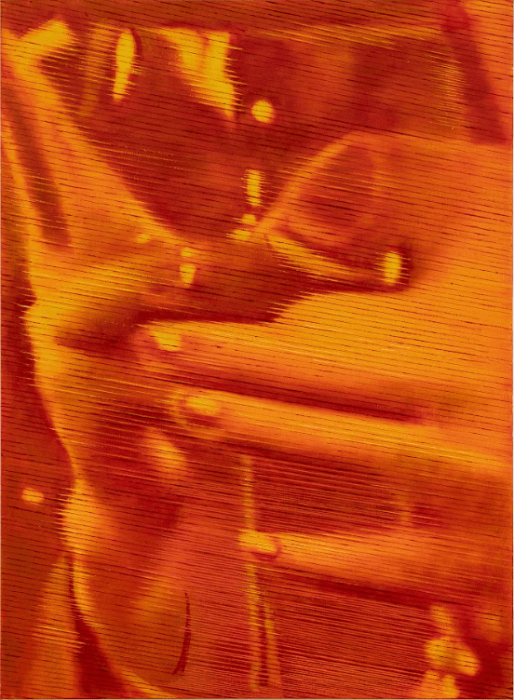
Transcript
At first, it is difficult to figure out exactly what Louise Giovanelli’s oil painting Offer is depicting; as the artist says, “ambiguity is what sustains a painting.” The canvas is 150 centimetres high and 110 centimetres wide or roughly 5 by 3 and a half feet. The colours in this oil painting are intense, varied tones of orange, ranging from a burnt reddish shade to a light amber glow. The painting depicts a closely cropped image of a wine glass, clasped elegantly between two hands, one of which balances a cigarette between two fingers. The butt of the cigarette is visible in the top left corner of the work, but the rest of it is cut off by the left edge of the image. Offer is based on an image taken from the 1990s British sitcom Absolutely Fabulous, although the artist intentionally decontextualises the image through tight framing, giving it the impression of a fragment of a wider narrative. The ambiguity of the picture is sustained by a blurring effect of thin diagonal lines that span the painting’s whole surface, reminiscent of scan lines on a television screen.
The image has a strong luminous quality, carefully created by the gradual building up of thin layers of pigment on the canvas. Inspired by Renaissance painting, Giovanelli’s technique creates an image that almost seems to glow from within. The motif of the wine glass and the luminosity of the painting reflect the artist’s interest in religious imagery and acts of worship, evoking the ritual of drinking while the distortion of the image mirrors the altered state of drunkenness. Giovanelli uses this fragmented moment from popular culture to reflect on new modes of devotion in the modern world. Rather than depicting ritual directly, Giovanelli draws parallels to social rituals, tapping into what is described as, in the artist’s words, the human need for “the higher being, the perfect being, idol worship and light and glitz and glamour.”
This work is on loan from the David and Indrė Roberts Collection
Anthony Cudahy (b. 1989)
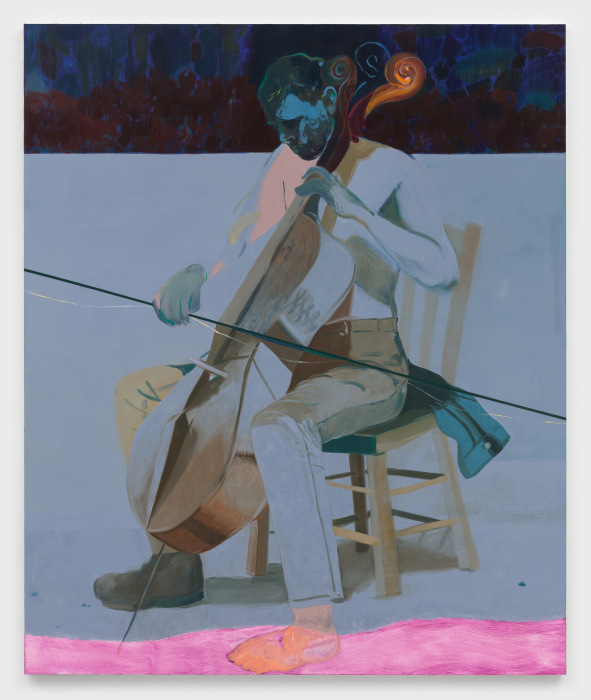
Transcript
This oil painting on linen measures close to 182 centimetres high and 152 centimetres wide or about 6 feet tall by 5 feet wide. It was painted by the artist Anthony Cudahy in 2023 and depicts the famous American ‘disco cellist’ Arthur Russell. Depicted large, at the centre of the work, Russell is caught in a moment of deep concentration and creative abandon while playing his cello. He sits on a chair at a diagonal angle to the viewer, facing towards the left-hand side of the painting. He holds the cello between his knees, the bow with his right hand, whilst his left holds the neck of the instrument. Russell is shirtless and has bare feet, but is wearing trousers. Most of the painting has a pale blue background. His torso and arms are the same pale blue, and are made visible by subtle contour lines. His thighs and parts of the cello are rendered in a muted beige. His head is more defined than the rest of his body, and is painted in a greenish-blue or a dark cyan. He looks down at his instrument as he plays, suggesting a deep concentration. The cello appears to have three separate heads fanning out at the top of the neck—one in dark brown, one in dark blue, and the third in a light brown. The sleeve of a teal shirt is draped on the seat of the chair. There is a pink stream running across the bottom of the painting, into which the cellist dips his left, bare foot. At the top of the painting, the artist has painted patches of colour of different sizes in hues of blue, green and brown. The long bow that Russell holds extends diagonally across the middle of the painting, and its strings hang down, giving it the appearance of a fishing rod.
Born in 1951 in Oskaloosa, Iowa, Arthur Russell was a cellist, composer, singer, and producer. Russell’s sound played a central role in shaping the New York queer disco nightlife and the downtown avant-garde scene of the 1970s. Cudahy pays homage to Russell, he says: “Music is really important to me. I’m always listening to Arthur Russell, he’s an anchor for me. He had this lyrical sensibility that makes his music feel highly personal when you listen to it,”
This painting is based on a photograph of Arthur Russell sitting on a beach, playing his cello in daylight, but Cudahy’s work has a dark, nocturnal colour palette, making it look as if the cellist is on a stage.
This work is on loan from the David and Indrė Roberts Collection
Celia Hempton (b. 1981)

Transcript
This painting by Celia Hempton measures 31 by 36 centimetres, or around 12 by 13 inches. It is rendered with bold, rapid strokes of paint. The artist depicts a white man in a blue shirt reclining onto a red cushion. The crop of the painting is tight, only the man’s left arm, torso and neck are visible. His arm is bent at the elbow and extends upwards towards his face, which is not shown in the painting. There is little sense of depth in the work: brushstrokes that form parts of the man’s body or parts of the background collide and overlap.
This work is part of an ongoing project which Hempton began in 2014 titled Chatrandom, a series of paintings which is named after a video chat website that randomly pairs users from across the globe. Often, the platform is used to facilitate sexual pleasure in front of a series of random observers. Hempton only paints what she sees on the screen in real time, and stops painting as soon as the connection is severed or her subject logs off. This is reflected in the quick, immediate brushstrokes that evoke a sense of urgency. The title of some of these works reveal the usernames of these individuals and the time and place of the interaction.
In creating this painting and other works in the same series, Hempton considers the way in which these online spaces are usually dominated by men. She states “In terms of the power dynamic, the bottom line is that I’m necessarily activating my gaze as a woman, and I can’t switch it off as long as I’m making the painting.” Yet, as the series progressed, these interactions became more complex. Hempton’s work raises questions of consent and voyeurism. As the artist herself asks: “When does looking become an act of trespass?”
This work is on loan from the David and Indrė Roberts Collection
Harry Gruyaert (b. 1941)
TV Shot. Men In Suits
TV Shot. Angie Dickinson
TV Shot. Dancers
1972
Archival pigment print
66 x 100 cm
On loan from the David and Indrė Roberts Collection
Transcript
These three works by Harry Gruyaert, archival pigment prints, are from the series TV Shots. Each print is in landscape format and is 66 by 100 centimetres or is just over 2 by 3 feet.
The first print, Men in Suits, shows a group of men wearing identical blazers, shirts and ties. They are male athletes at the opening ceremony of the 1972 Olympics. They face the same direction, towards the bottom right hand corner of the photograph. The walking men fill the whole image, cropped at either side, suggesting that they are part of a larger procession. The most striking element of the image is the bright, garish colour palette—the men’s blazers and skin are a bright shade of orange, which contrasts with their pale blue shirts and ties. This oversaturation, which is achieved by the artist changing the colour settings on his television, emphasises the uniformity and anonymity of the men in the image —it is very difficult to tell one man apart from another. The effect is heightened by the blurring of the image.
The second work, Angie Dickinson, shows a man and a white woman who are about to kiss. The face of the woman that fills the right-hand side of the image is that of American actress Angie Dickinson. Her eyes are closed and her lips parted. On the left of the photograph, only the back of the man’s head is visible. The colours of the image are cold and highly saturated—the woman’s skin is bright pink in colour, whilst the man’s head is dark blue. Both man and woman are dappled with brighter and darker patches of colour. Lines of distortion run horizontally across the whole of the image, recalling an analogue tv screen.
In Dancers, eight pairs of individuals dance in two lines of four, spanning the width of the photograph. Each pair of dancers looks the same—a man in a dark grey suit and a woman in a bright pink dress which flares outwards as they dance. The pairs are all in a waltz pose. The men’s backs are facing the camera, obscuring the women they dance with. The image is taken from a high viewpoint; it shows the full height of the dancers and the tops of their heads. The wooden dance floor extends beyond the dancers, and a seated audience at the top edge of the photograph. The saturation of the image gives the flooring a greenish-yellow tinge, while a blur shows the motion of the subjects: the dancers are spinning across the floor at speed.
These works are on loan from the David and Indrė Roberts Collection.
Philip-Lorca diCorcia (b. 1951)
Untitled
Undated
Polaroid mounted on aluminium
8.4 x 10.6 cm
On loan from the David and Indrė Roberts Collection
Transcript
This small, landscape polaroid photograph by the American artist Philip-Lorca diCorcia is about 8 centimetres tall and 11 centimetres wide or 3 by 4 inches. It depicts two white men, sitting at a slight distance to each other by the window of a bar or diner. The scene is cinematic and takes place at dusk or nighttime. Both men sit in slouched, relaxed poses, resting one arm on the long bar behind them. The man to the left of the picture, wears casual trousers and a t-shirt, and swigs from a bottle of beer held in his left hand. The man on the right is dressed in a white shirt and tie, his gaze fixed on the man to the left of the scene. Behind the two men, metal shutters are drawn across the window; it seems to be past closing time. Two large neon signs also hang behind the window, facing outwards onto the street. Their light also shines into the bar, flooding the scene with a dramatic green and red glow. The sign on the left in green, reversed in the image, reads Blarney Stone, and the sign on the right in red reads Sandwiches, Daily Specials, Hot Plates also in reverse. This polaroid was shot as part of an editorial project by diCorcia in collaboration with ‘W’ fashion magazine, and reflects his ability to stage dramatic yet ambiguous scenes.
This work is on loan from the David and Indrė Roberts Collection.


